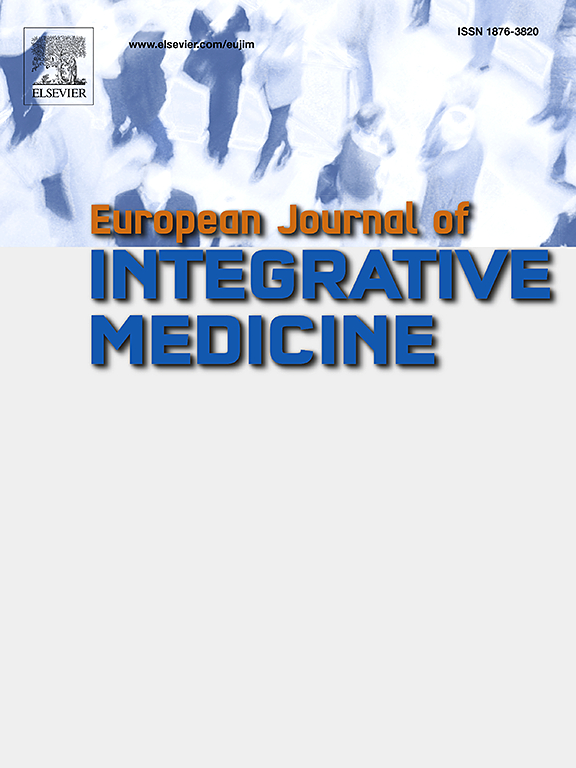Hotspots and trends in global antiviral herbal basic research: A visualization analysis
IF 1.7
4区 医学
Q3 INTEGRATIVE & COMPLEMENTARY MEDICINE
引用次数: 0
Abstract
Introduction: Viral infections can become public health emergencies due to the possibility of the wide transmission of their associated pathogens and their rapid variation. Moreover, most viruses lack effective therapeutic drugs and vaccines. Herbal medicines have been clinically validated for their broad-spectrum antiviral properties and their ability to leverage their complex compositions to target multiple levels, pathways, and channels. In this study, we seek to assess the current global research landscape and identify current and future directions for research on antiviral herbal medicines to guide future pharmacological developments. Methods: Bibliometric and visualization methods were used to analyze 2134 Chinese-language and 4600 English-language journal articles published between 2017 and 2022 from both Chinese and international databases, and the theme words and foci of highly cited papers were analyzed. Results: It was found that coronaviruses (especially severe acute respiratory syndrome coronavirus 2, SARS-CoV-2), the influenza virus, the hepatitis B virus, and the human immunodeficiency virus were the primary targets for antiviral herbal medicines. Key herbs included Glycyrrhiza glabra, Lonicera japonica, Scutellaria baicalensis, Ephedra sinica, Forsythia suspensa, Agastache rugosa, Astragalus membranaceus, and Poria cocos. The primary active compounds known to be responsible for these antiviral effects are alkaloids, bioflavonoids, flavonoids, sterols, and polyphenols, including curcumin, quercetin, kaempferol, wogonin, stigmasterol, β-glutosterol, luteolin, coumarins, naringenin, gallic acid, berberine, and andrographolide. These compounds work through mechanisms such as inhibiting viral replication, blocking virus–receptor interactions, destroying viruses, regulating the immune response, oxidative stress induction, and cytokine response suppression. Conclusions: The research foci included the pharmacodynamic foundations, molecular dynamics simulation, and virtual screening of active components in herbs use for the treatment of viral diseases such as SARS-CoV-2 using bioinformatics, macromolecular docking, and network pharmacology. Significant gaps remain in interdisciplinary collaboration, especially regarding herb cultivation, processing, sustainable harvesting, and potential drug interactions.
全球抗病毒草药基础研究的热点和趋势:可视化分析
导言:病毒感染可能成为公共卫生突发事件,因为其相关病原体可能广泛传播,而且变异迅速。此外,大多数病毒都缺乏有效的治疗药物和疫苗。中草药的广谱抗病毒特性及其利用复杂成分靶向多层次、多途径和多通道的能力已得到临床验证。在本研究中,我们试图评估当前的全球研究状况,并确定当前和未来的抗病毒中药研究方向,以指导未来的药理学发展。研究方法采用文献计量学和可视化方法分析了2017年至2022年期间发表的2134篇中文期刊论文和4600篇英文期刊论文,分别来自中文和国际数据库,并分析了高被引论文的主题词和病灶。结果发现发现冠状病毒(尤其是严重急性呼吸系统综合征冠状病毒2,SARS-CoV-2)、流感病毒、乙型肝炎病毒和人类免疫缺陷病毒是抗病毒中药的主要靶标。主要药材包括甘草、忍冬、黄芩、麻黄、连翘、黄芪和茯苓。已知具有抗病毒作用的主要活性化合物是生物碱、生物类黄酮、类黄酮、甾醇和多酚,包括姜黄素、槲皮素、山柰酚、木犀草素、豆甾醇、β-谷甾醇、木犀草素、香豆素、柚皮苷、没食子酸、小檗碱和穿心莲内酯。这些化合物通过抑制病毒复制、阻断病毒与受体的相互作用、破坏病毒、调节免疫反应、诱导氧化应激和抑制细胞因子反应等机制发挥作用。结论研究重点包括药效学基础、分子动力学模拟,以及利用生物信息学、大分子对接和网络药理学对治疗 SARS-CoV-2 等病毒性疾病的中草药活性成分进行虚拟筛选。在跨学科合作方面仍存在巨大差距,特别是在草药种植、加工、可持续收获和潜在的药物相互作用方面。
本文章由计算机程序翻译,如有差异,请以英文原文为准。
求助全文
约1分钟内获得全文
求助全文
来源期刊

European Journal of Integrative Medicine
INTEGRATIVE & COMPLEMENTARY MEDICINE-
CiteScore
4.70
自引率
4.00%
发文量
102
审稿时长
33 days
期刊介绍:
The European Journal of Integrative Medicine (EuJIM) considers manuscripts from a wide range of complementary and integrative health care disciplines, with a particular focus on whole systems approaches, public health, self management and traditional medical systems. The journal strives to connect conventional medicine and evidence based complementary medicine. We encourage submissions reporting research with relevance for integrative clinical practice and interprofessional education.
EuJIM aims to be of interest to both conventional and integrative audiences, including healthcare practitioners, researchers, health care organisations, educationalists, and all those who seek objective and critical information on integrative medicine. To achieve this aim EuJIM provides an innovative international and interdisciplinary platform linking researchers and clinicians.
The journal focuses primarily on original research articles including systematic reviews, randomized controlled trials, other clinical studies, qualitative, observational and epidemiological studies. In addition we welcome short reviews, opinion articles and contributions relating to health services and policy, health economics and psychology.
 求助内容:
求助内容: 应助结果提醒方式:
应助结果提醒方式:


